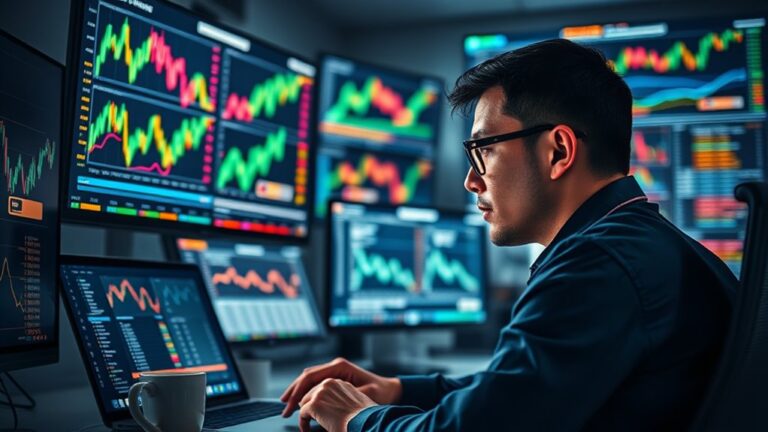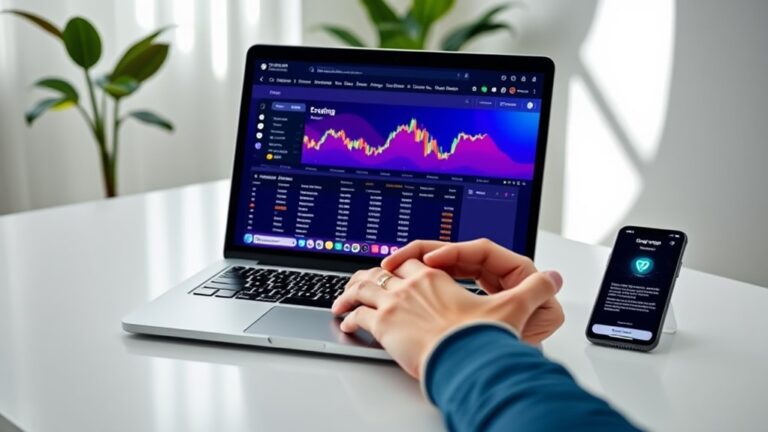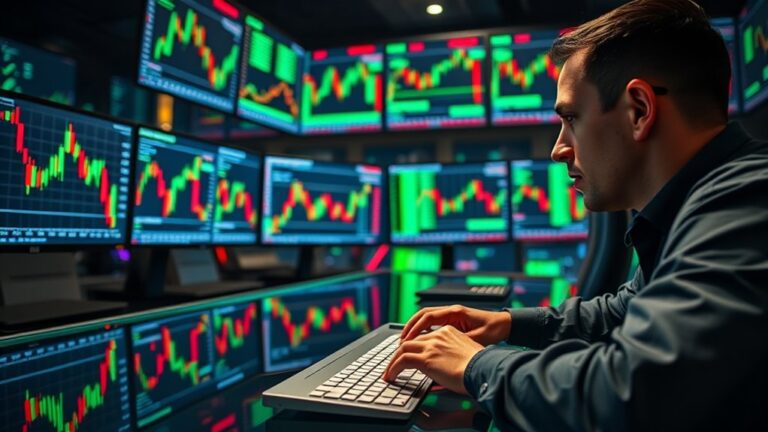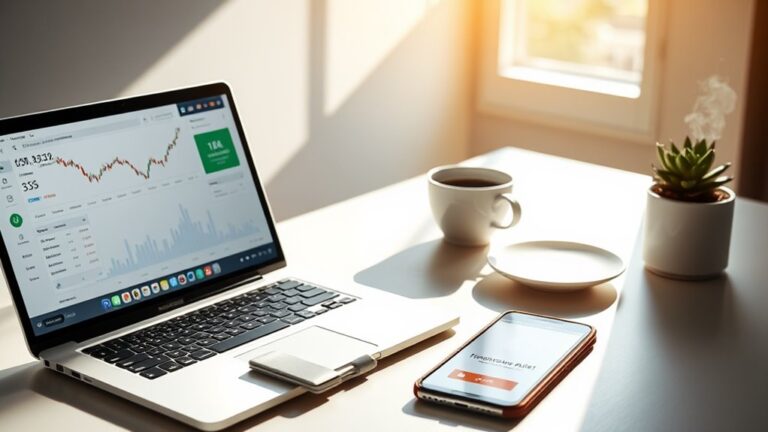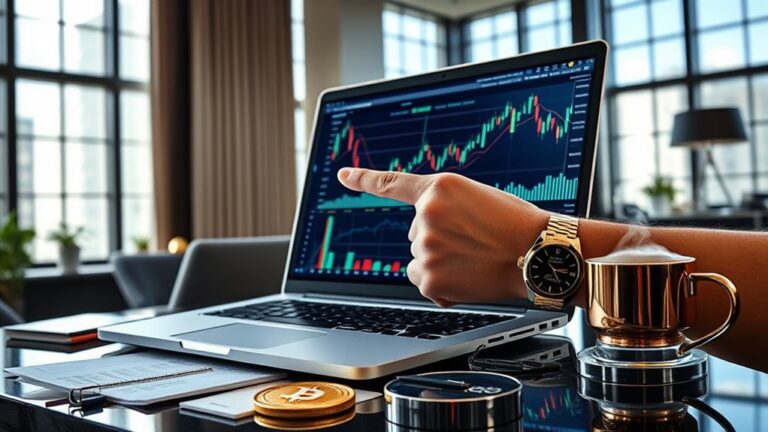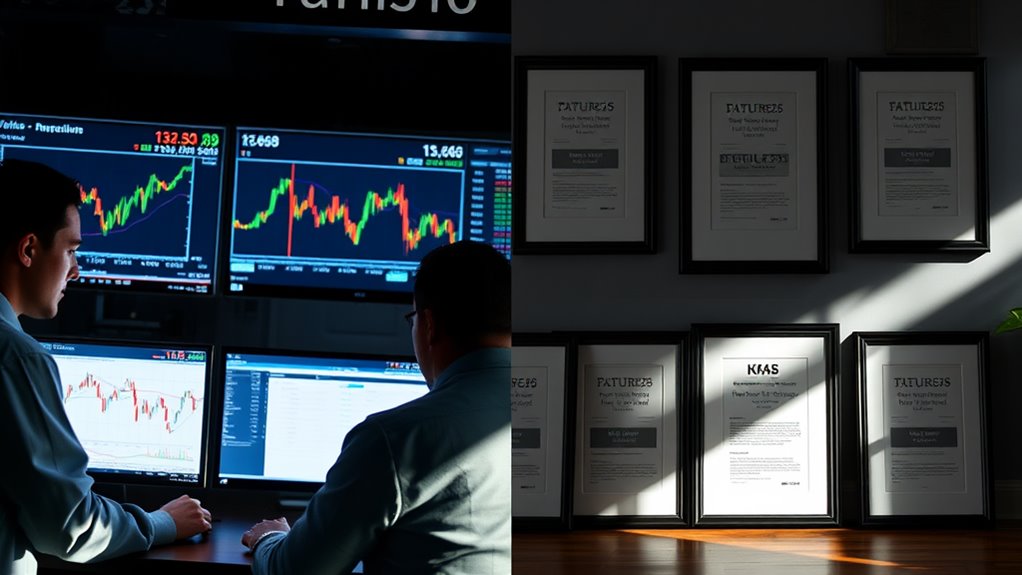
Spot Trading vs Futures Trading: Which Strategy Fits Your Risk Tolerance?
Choosing between spot trading and futures trading hinges on risk tolerance and capital. Spot trading, less risky with immediate asset ownership, demands full upfront payment, suitable for those averse to high risk. Futures trading, leveraging capital to anticipate price movements, presents higher risks and rewards, appealing to risk-tolerant investors. Understanding each method's demands helps align your preferences with the appropriate trading strategy, paving the way for a more in-depth exploration of tailored investment avenues.
Key Takeaways
- Spot trading offers less risk with direct asset ownership, ideal for lower risk tolerance.
- Futures trading involves leverage, suitable for higher risk tolerance with potentially greater returns.
- Full upfront payment in spot trading ties up more capital, whereas futures trading offers higher capital efficiency.
- Stop-loss orders are critical in managing losses in both trading types but are crucial in the higher-risk environment of futures trading.
- Regulatory burden and costs are lesser in spot trading, preferable for those cautious about complexities and higher expenses.
Understanding the Basics of Spot and Futures Trading

In exploring the domains of financial trading, it is essential to understand the basic principles of spot and futures trading.
Spot trading entails the immediate purchase or sale of financial assets like currencies, commodities, and cryptocurrencies at current market prices, often settling within two business days. This market is marked by high liquidity and offers various assets through online platforms.
In contrast, futures trading involves agreeing today on the price for future asset delivery, allowing speculation on price movements. Futures operations, offering potential for greater leverage, require traders to engage with more complex strategies and maintain higher risk awareness.
Each trading type serves different investor needs, from immediate liquidity and accessibility in spot trading to speculative, strategic positions in futures.
Analyzing Risk and Capital Requirements in Trading

While various factors influence trading decisions, understanding the risk and capital requirements is critical for both novice and experienced traders.
Spot trading is typically seen as less risky because it involves owning the asset directly without leverage, suitable for those with low risk tolerance. However, it requires full payment upfront, potentially tying up a significant amount of capital without the benefit of leverage.
On the other hand, futures trading, characterized by the use of leverage, can lead to higher returns but also increases the risk of substantial losses. It allows traders to control large positions with a fraction of the total value upfront, making it more capital efficient but suitable mainly for those who can manage higher risks.
To manage these risks effectively, traders should consider implementing stop-loss orders, which can prevent significant losses by automatically selling assets at a set price.
Navigating Market Complexity: Skills and Knowledge Needed

As traders venture into the world of spot and futures trading, mastering certain skills and acquiring thorough market knowledge are imperative for successfully traversing this complex landscape. Understanding market volatility, especially in unpredictable assets like cryptocurrencies, affects critical trading decisions. Spot trading's simplicity in transaction mechanism contrasts with the complexities of futures trading, where leverage and market predictions play significant roles. Effective traders employ technical analysis to discern market trends and rely on robust research to inform their moves. Also, managing emotions and maintaining discipline are essential to withstand psychological pressures of trading. Finally, experience enhances adaptability to swiftly changing market conditions, a pivotal ability for any successful trader. Emphasizing risk management is crucial, as highlighted by insights on the importance of understanding leverage, volatility, and market trends.
Setting Your Investment Goals and Time Horizons

Before setting out on any investment journey, understanding one's investment goals and time horizons is essential. Investment goals include aspirations like saving for retirement or purchasing a home, with their achievement timeline defining their nature: short, medium, or long-term. Choosing the right investments often hinges on these time frames, with shorter horizons necessitating safer assets and longer spans allowing for riskier options due to the potential for recovery.
| Goal Type | Time Horizon | Suitable Investments |
|---|---|---|
| Short-term | Less than 3 years | Bonds, Money Markets |
| Medium-term | 3-10 years | Mixed Asset Funds |
| Long-term | More than 10 years | Stocks, Real Estate |
| Flexible Goals | Varies | Equities, Commodities |
| Retirement | Decades | Diversified Portfolio |
Adapting strategies to align with these frameworks guarantees that the investment path chosen minimizes risks and maximizes opportunities for achieving set financial targets.
Regulatory and Cost Considerations in Different Trading Strategies

Understanding the regulatory and cost implications is essential when comparing spot trading and futures trading as different investment strategies.
Spot trading, often with fewer regulatory hurdles, varies by jurisdiction, presenting a simpler framework in countries like El Salvador compared to the strict regulations in the U.S.
Futures trading, conversely, faces stringent oversight by entities such as the CFTC, demanding more complex compliance due to its leveraged nature and structured contracts aimed at preserving market integrity.
Cost-wise, spot traders encounter lower fees primarily through transactions and spreads.
Futures traders, however, manage higher costs including margin interest and rollover fees, offset by the capital efficiency and reduced slippage through higher market liquidity, facilitating larger trade volumes at potentially lower costs.
In this context, understanding how different countries apply crypto regulations(/navigating-crypto-regulations-balancing-oversight-and-innovation) can significantly influence the decision between spot and futures trading.
Frequently Asked Questions
How Does Geopolitical Tension Affect Spot Versus Futures Trading?
Geopolitical tension increases market volatility and risks, impacting spot trading by causing immediate price fluctuations and liquidity concerns. In futures trading, it affects price speculation, margin requirements, and offers opportunities for hedging against such uncertainties.
Can I Use Both Spot and Futures Trading to Diversify Risk?
Yes, using both spot and futures trading can diversify risk by balancing immediate ownership with opportunities for leveraging based on predictions, thereby maneuvering through different market conditions and enhancing overall investment strategy stability.
What Are the Environmental Impacts of Trading Futures?
Trading futures generally has a neutral environmental impact as it involves no direct exchange of physical goods. This activity primarily focuses on risk management and liquidity provision without altering commodity production levels.
How Do Interest Rate Changes Specifically Impact Futures Contracts?
As the tide turns with interest rates, futures contracts feel the pull. Higher rates lower bond futures prices and increase cost of carry in futures, reducing market liquidity and heightening volatility across trading platforms.
Are There Ethical Considerations Unique to Futures Trading?
Yes, futures trading harbors unique ethical considerations including the potential for market manipulation, price volatility effects on consumers, and the broader impact of speculative trading on economic and financial stability.
Conclusion
In summary, whether choosing spot trading or futures trading largely depends on individual risk tolerance and investment goals. Notably, over 65% of traders indicate that understanding their risk capacity influenced their trading strategy choice greatly. Both methods require knowledge of market dynamics, but the capital and regulatory demands differ. It's essential to weigh these factors carefully to align with your financial objectives and market approach, ensuring you adopt a strategy that best fits your profile.


